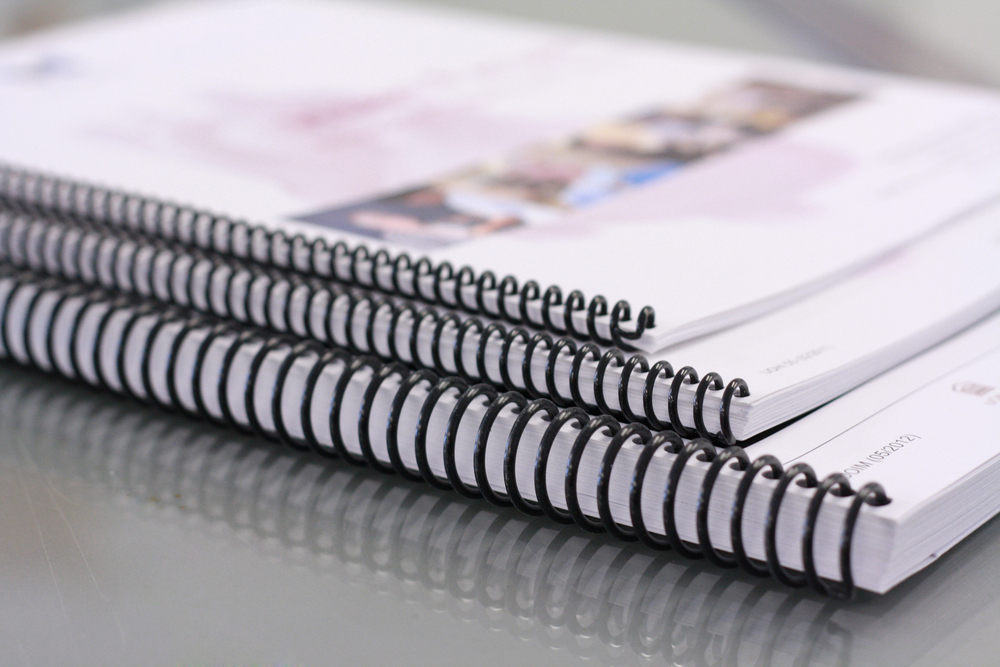Binding styles help determine the functionality and aesthetics of printed projects like books and presentations. Your choice of binding method can depend on various factors, including the purpose of the printed material, the number of pages, and the desired durability. Here are several binding styles offered by printing services:
Perfect Binding
Perfect binding uses an adhesive to bind sections of pages together at the spine. The adhesive used is a flexible, hot-melt glue that creates a strong bond between the pages and the cover. Attaching the cover to the bound pages creates a clean and professional appearance. Perfect binding offers durability and is ideal for publications like catalogs and paperback books.
Comb Binding
Comb binding is used for books with punched holes, allowing for easy page removal and replacement. The book spine is made of plastic and composed of spiral rings that slip through the punched holes in the cover and pages. This versatile binding style is suitable for books meant to be opened up and laid flat, such as manuals and albums.
Hardcover Binding
Hardcover binding attaches a cover to an adhesive sheet and affixes it to rigid boards using cloth or vinyl. The interior pages are then grouped and glued or sewn into the spine. This method can be used to preserve books containing records or histories. The rigid cover protects the pages from bending, tearing, and other damage, making it suitable for books that will be handled frequently or stored for long periods. Hardcover binding also offers a high-quality appearance and is good for novels, photo books, and special editions.
Velo Binding
With velo binding, the printing company pierces small holes into the book’s edge and threads a strip with rigid plastic tines through the covers to secure them firmly. Printing services may recommend using this method for documents that will be shared among multiple readers. This can include legal briefs, business proposals, and contracts.
Tape Binding
When using the tape binding method, a wide tape strip is applied to the spine with thermoplastic glue. The binding machine applies heat to the adhesive tape, melting it and causing it to adhere firmly to the pages. This process makes the binding strong and durable. The tape binding provides a clean and professional appearance. It can also be customized in color and material to match the document or enhance its visual appeal.
Saddle Stitching
Saddle stitching involves folding sheets of paper in half and stapling them together along the folded crease, creating the spine. The staples are typically inserted through the centerfold of the folded sheets, creating a booklet-like appearance. Saddle stitching may be used for booklets, magazines, newsletters, event programs, and promotional brochures. It is ideal for publications where a compact size, affordability, and ease of distribution are key requirements.
Spiral Binding
Spiral binding is an ideal method for books or documents that must lay flat, such as manuals or cookbooks. During the process, the binding machine punches small circular or oval holes in the cover and pages. It then uses a plastic coil to bind them. The coil spine allows pages to turn smoothly and withstand frequent handling without becoming loose or falling out.
Wire Binding
This binding style uses a closed-loop metal wire that passes through special square holes punched into the covers and pages. Wire binding can accommodate a wide range of page counts, generally from a few sheets up to several hundred pages. Like spiral binding, one of the main advantages of wire binding is its ability to lay completely flat when opened.
Choose High-quality Printing Services
Printing services offer advice on choosing the most appropriate binding method based on the type of document, its intended use, and page count. You can choose from various styles to customize your project and create a functional final product. Contact a professional printing company today to learn more about their binding styles.

